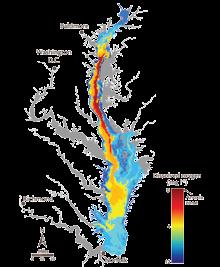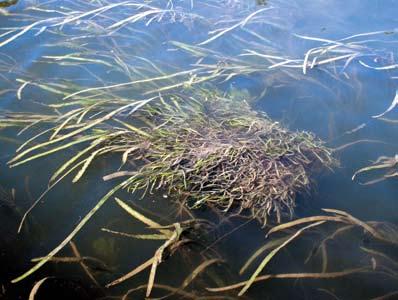
6 minute read
Waterkeepers Chesapeake
By Michele Merkel, Chesapeake Regional Coordinator
Ninety percent of Chesapeake Bay and its tidal waters are impaired from nutrient pollution. In the Chesapeake 2000 Agreement, leaders from Virginia, Maryland, Pennsylvania, the District of Columbia and the federal EPA pledged to get the bay off EPA’s list of impaired waters by 2010. Current predictions for meeting this goal are dire.
S o u th R iverkeeper
Algae bloom at Betterton Beach on the Sassafras River, MD. This algae, microcystis, produces a toxin that can cause illness, including gastroenteritis, and has killed livestock and pets.
»Ev ery year nearly half the Chesapeake Bay has too little oxygen to support most aquatic life, creating a dead zone stretching for hundreds of square miles. The Chesapeake Bay Program, a federal-state agency charged with directing bay restoration, recently reported that there are no prospects of likely recovery. They predicted continued harmful algal blooms causing beach closures and fish kills like the one this June that caused 7,000 menhaden to go belly up in the Baltimore Harbor. Why have the federal and state governments given up on the bay?
We know what the problem is. We know what the solutions are. Stop nutrient pollution from industrial agriculture, sewage systems and stormwater runoff from reaching the water. We have piles of reports and initiatives, strategies and assessments. Now it’s time to start at the top of the list and cut the sources of pollution. With government moving at glacial speed, the Waterkeepers Chesapeake are picking up the pace of our efforts to protect the bay from nutrient pollution using litigation, regulatory and legislative strategies.
Keeping Waste Out of the Bay Earlier this year, Shenandoah Riverkeeper, Potomac Riverkeeper and Waterkeeper Alliance put two companies, Pilgrim’s Pride Corporation and Cargill Meat Solutions Corporation, on notice that we will sue them for dumping poultry waste into the North Fork of the Shenandoah River in Timberville, Virginia.
PPC and Cargill send 360 million gallons of poultry processing waste to the failing SIL wastewater treatment facility each year. In 2005, the SIL facility exceeded their phosphorous pollution limits by an astounding 900 percent. Tests showed phosphorous levels in the river 140 times greater below the outflow for SIL than above. These violations continued into 2006. As a result of the notices of intent to sue, the Virginia Department of Environmental Quality stepped in and is requiring the facility to install treatment technology that will slash pollution.
However, the Shenandoah and Potomac Riverkeepers’ work is far from over. The Virginia Fish Kill Task Force recently hypothesized that poultry litter is a likely contributor to the substantial number of fish kills that have occurred each year since 2004 in the Shenandoah River.
To the North, in Pennsylvania, the Lower Susquehanna Riverkeeper is also hard at work tackling industrial agriculture. Earlier this year, the Lower Susquehanna Riverkeeper and Penn Future threatened to sue five industrial agriculture operations for operating without a Clean Water Act permit. Those actions compelled three of the facilities to obtain permits. One of the facilities chose to reduce their livestock below numbers that require a permit. The fifth facility is still under the Riverkeeper’s watchful eye — they claim that their facility is really two separate facilities, neither of which is large enough to require a permit. More recently, Lower Susquehanna Riverkeeper in coalition with other state groups successfully pushed Pennsylvania legislation that makes tax credits available to farmers and businesses who install conservation projects that reduce water pollution.
Waterkeepers Chesapeake are also working to keep human waste out of the bay. One of the primary sources of nutrient pollution in the West and Rhode Rivers is from recreational boaters. Because the Coast Guard and the state have failed to enforce the laws that prohibit the dumping of wastewater from boats, the West and Rhode Riverkeeper decided to take matters into his own hands, convincing the city of Annapolis to donate a pumpout boat. With operating assistance from the state and with help from many volunteers, the West and Rhode Riverkeeper now operates the pump-out boat “Honeydipper” on the West and Rhode Riv
R iverkeeper
S evern
Monitoring the Severn
Good News?
EPA predicted a ‘moderate’ year for the Chesapeake’s anoxic dead zone. Little comfort for fishermen, boaters and wildlife of the bay. Hint: the blue water is healthy and safe.
U.S. EPA Chesapeake Bay Program
ers. As of August 1, 55 boats had been serviced by the Honey Dipper, properly disposing of more than 1,000 gallons of sewage.
Protecting the Bay from Urban Development Stormwater runoff has a significant impact on water quality in the Chesapeake. This spring the Maryland legislature passed the Stormwater Management Act, which will drastically change how developers plan for and handle polluted runoff from new developments. The Patuxent Riverkeeper, along with the South Riverkeeper, the Baltimore Harbor Riverkeeper, the Severn Riverkeeper and the Assateague Coastkeeper, marshaled a broadbased coalition of groups to assist the state to develop regulations that require environmental site design practices to mitigate stormwater pollution from development.
But regulations — no matter how strong — are only as good as their enforcement. Last month, South Riverkeeper Drew Koslow put a developer on notice that he intended to sue him for 179 discharges of contaminated stormwater in violation of Maryland’s General Permit conditions and the Clean Water Act.
We Will Restore the Bay Despite the failure of government to step up to the plate, the Waterkeepers of the Chesapeake region refuse to accept the current health of our bay. We know what the problems are and how to fix them. The relevant question becomes — do we have the will to restore the Chesapeake?
As Tom Horton, an environmental journalist, has said, “Public support often seems like the estuary itself, impressively broad but deceptively shallow.” The Waterkeepers Chesapeake will continue to play their unique role of connecting communities, our laws and our values to the well-being of the bay so that citizens will hold themselves, polluters and their elected officials accountable. Only then will we restore the bay’s oysters and crabs, put our watermen back to work, and preserve a way of life that makes the bay unique.
A wild celery and water star underwater grass bed. At the turn of the century, an emerald cloak of underwater grasses lined the Cheseapeake Bay and its tributaries, providing hiding places for blue crabs and spawning fish. Today, nutrient pollution has killed about twothirds of the bay’s underwater grass beds. Without these beds crabs, fish and waterfowl disappear. With them go the fresh, plentiful seafood, jobs for watermen and safe places for our kids to fish and swim.
L ange

By Allison Albert, Severn Riverkeeper Program Director
Severn Riverkeeper with the help of Arlington Echo Outdoor Education Center has been monitoring dissolved oxygen levels in Maryland’s ‘capital river’ for the past two summers and has gathered some unsettling data. Surface dissolved oxygen measurements taken from 18 stations on the river generally showed healthy levels. In summer, however, oxygen levels near the bottom all scored below the EPA designated “healthy” threshold, measuring at low oxygen levels characteristic of a dead zone. These conditions were easily confirmed by detectable levels of hydrogen sulfide, a product of anaerobic bacterial metabolism.
Dead zones normally exist only in deep water where little mixing of layers occurs, not flowing rivers. Sadly, the Severn is proving that rivers are suffering from low oxygen levels. Last spring the Riverkeeper presented this important finding along with policy recommendations to Maryland Governor Martin O’Malley and the Anne Arundel County Executive. We continued our monitoring effort this summer with similar preliminary results.










